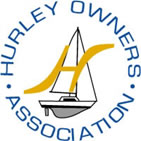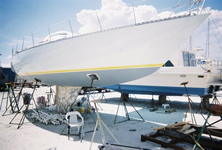



TAILWIND 38
HURLEY TAILWIND GENERAL SPECIFICATION
Length overall - 38ft 2in
Length waterline - 30ft 2in
Beam - 11ft 11in
Draft - 6ft 6in
Displacement - 7.2 tons
Working sail area - 663 ft²
The Tailwind 38 was designed and built during the last few years before the demise of Hurley Marine in early 1974. They were a fast and powerful cruiser/racer and used a rig which was also designed by the vessels designers Bergstrum and Ridder (B&R). B&R Rigging Inc is still going strong and makes rigs for the Hunter (Legend in UK) range built in Florida. These unusual fractional rigs don't have backstays but work well. We are not sure exactly how many Tailwinds and Sailwind 27's were built but we do know that most of the Tailwinds were taken to the USA for long distance racing.
Participation in ocean racing has been graphically described as comparable to standing under a cold shower and tearing up ten pound notes. In the original it was five pound notes but inflation has hit yachting as hard as anything else. Certainly the Hurley Tailwind is beyond the reach of the poor and needy. The finished boat cost£25,750 and to that must be added approximately another £1000 for navigational instruments, £3000 for sails and perhaps £1000 for various optional extras.
But that is only a small part of the picture. For the Tailwind is the result of eight years work, including six years of tank and wind tunnel testing by the designers Lars Bergström, Sven-Olov Ridder and their catalyst Bjorn Lindell. Ridder is an aero-dynamicist, head of the wind tunnel research department at the Swedish Royal Institute of Technology and a designer of Saab planes. Bergström was 27 before he did any sailing at all. Then he paid £2.50 for a submerged 70ft yacht with a 9ft beam which he managed to raise and refit. He set off round the Baltic in her on his own, frightened himself to death a few times and came back both competent and addicted.
Out of a meeting between Bergström and Ridder was born the company B&R Designs which, over the last 10 years, has built up a notable reputation for research into keel and rigging design using tank and wind tunnel testing systems. Their designs have been used by leading boatbuilders, including both Dick Carter and Sparkman & Stevens, the firm which built Ted Heath's most recent Morning Cloud.
The Tailwind is a fairly typical mid-'seventies cruiser/racer, a family boat which can sleep seven in substantial comfort (cooker, oven, twin sinks, fridge and shower compartment) or a nine-up racing boat. She is moulded in grp in two parts, the deck and hull, which are bonded together. The skeg rudder is coupled to a geared steering wheel mounted in a small steersman's cockpit right back aft, well away from the large central crew's cockpit, known as the 'gorilla pit'. Apart from a battery of 12 winches, the deck is clean. But the two elements which took up most of the development time were the keel and the rigging, for it is true to say that however efficient the hull lines, a yacht only goes fast if it has a properly thought-out keel and rudder down below and well designed spars and rigging up above.
She has a three ton lead fin keel which has spent more time undergoing wind tunnel tests than tank tests because, according to Bergström, at sailing speeds, water and air behave according to the same laws. But the rigging is an oddity even to a relatively untrained eye, more like a transmitter mast than the average nautical version. The aim of the B&R design is primarily to reduce windage (wind resistance) and secondly to improve airflow across the mainsail. Very roughly, the theory on a simple form of rigging is that the bigger the boat and therefore the sails, the thicker the mast has to be to take the strain. But a tall thick mast presents a huge blocking frontal area to the wind. Bergström and Ridder claim to have reduced drag by designing a mast which is substantially slimmer in section than a conventional mast, making up for the loss in strength by bracing it with double spreaders which are swept aft at 30º (an unusually acute angle) and linking them with a double diamond of stainless steel rod, as well as the conventional stays from the masthead through the ends of the spreaders to the deck.
It looks like a rigger's nightmare and has brought forth a torrent of dismissive comment from a sporting fraternity traditionally more nervous of real innovation (as opposed to new bits of gadgetry) than the Athenaeum and the MCC put together. Bergström considers it to be simplicity itself. 'You can stay the mast when it is lying on the ground, drop it onto the boat, tighten the shrouds and the backstay and that's that. After that, all the strain created when the boat is under sail is taken by the hydraulically tensioned forestay.' One obvious advantage is that the number of rigging attachment points on deck is minimised and there is no inner forestay at all. So Double O Too's crew, owner Rex Hay and Hurley's sales manager John Turner, have found it easier to change from one 'point of sailing' to another since there is less rigging to foul up the headsails or the spinnaker pole. They also believe that because the headsails can be sheeted home to a point closer than usual to the centre line, the boat is performing unexpectedly well to windward. Double O Too can make 7-9 knots at 26º off the wind. But her most spectacular burst of speed was 16 knots surfing under spinnaker. However, sustained speed over long periods will win this race and nobody yet knows enough about the Hurley Tailwind to decide if she really is the innovator which B&R hopes.